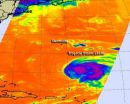(Press-News.org) RICHLAND, Wash. – Today's light-emitting diode light bulbs have a slight environmental edge over compact fluorescent lamps. And that gap is expected to grow significantly as technology and manufacturing methods improve in the next five years, according to a new report from the Department of Energy's Pacific Northwest National Laboratory and UK-based N14 Energy Limited.
"The light-emitting diode lamp is a rapidly evolving technology that, while already energy efficient, will become even more so in just a few short years," said Marc Ledbetter, who manages PNNL's solid-state lighting testing, analysis and deployment efforts. "Our comprehensive analysis indicates technological advancements in the near future will help people who use these lamps to keep shrinking their environmental footprints."
The report examines total environmental impact, including the energy and natural resources needed to manufacture, transport, operate and dispose of light bulbs. Fifteen different impacts were considered when evaluating environmental footprints, including the potential to increase global warming, use land formerly available to wildlife, generate waste and pollute water, soil and air. The report examines the complete life cycles of three kinds of light bulbs: light-emitting diodes, also called LEDs, compact fluorescents, or CFLs, and traditional incandescent light bulbs.
Completed for the Solid-State Lighting Program of DOE's Office of Energy Efficiency & Renewable Energy, this is the first public report to examine the environmental impact of LED manufacturing in depth. Manufacturing processes contribute substantially to a light bulb's overall environmental impact, but companies generally keep manufacturing information private. The research team was able to gather manufacturing data with the help of industry consultants and some companies on the condition that the final report would not reveal individual company data.
Incandescents lose out
To do the analysis, the team chose specific bulbs that best represent what's most typical and widely available for each of the three types of lights they studied. They then used a database to calculate the resources needed to produce the various components of the three light bulbs. That analysis revealed both LEDs and CFLs are substantially more environmentally friendly then traditional incandescents, which consume far more electricity. For example, the specific incandescent light bulb the team studied consumes 60 watts of electricity, while the LED model they studied uses just 12.5 watts and the representative CFL only uses 15 watts to create about the same amount of light.
"By using more energy to create light, incandescent bulbs also use more of the natural resources needed to generate the electricity that powers them," Ledbetter said. "Regardless of whether consumers use LEDs or CFLs, this analysis shows we could reduce the environmental impact of lighting by three to 10 times if we choose more efficient bulbs instead of incandescents."
The energy consumed by lights when they're turned on makes up the majority of their environmental impact. But, with power consumption being similar between LEDs and CFLs when they are lit, the research team found the difference between those two bulbs' overall environmental performance is largely determined by the energy and resources needed to make them.
No aluminum advantage
CFLs were found to cause slightly more environmental harm than today's LED lamp in all but one of the 15 impact areas studied. The one standout area was generating hazardous waste that must be taken to a landfill. This is because LED lights include a component called a heat sink, a ribbed aluminum segment that is attached to the bottom of LED bulbs. Aluminum heat sinks absorb and later dissipate heat that's generated by the light bulb, preventing it from overheating. The process to mine, refine and process the aluminum in heat sinks is energy-intensive and creates several byproducts such as sulfuric acid that must be taken to a hazardous waste landfill.
But soon, research and development is expected to further improve LED efficiencies, which in turn will reduce the amount of heat they produce and the size of heat sink they require. The research team found that this, and other improvements in manufacturing processes and electronics, will lead LED bulbs to be even more environmentally friendly than CFLs within five years. The team expects the LED bulb of 2017 will have 50 percent less environmental impacts than today's LED lamps and 70 percent less impacts that those found in today's CFLs, which are not expected to change significantly in the near future.
Next, PNNL will examine the amount of hazardous materials that exist in LED, CFL and incandescent lights and whether those materials are present in levels that exceed federal and California waste disposal regulations.
This and other DOE reports on solid-state lighting are available online at www.ssl.energy.gov/tech_reports.html.
INFORMATION:
REFERENCE: Heather E. Dillon and Michael J. Scholand, "Life-Cycle Assessment of Energy and Environmental Impacts of LED Lighting Products, Part 2: LED Manufacturing and Performance," June 2012, http://apps1.eere.energy.gov/buildings/publications/pdfs/ssl/2012_led_lca-pt2.pdf
SIDEBAR: How do different light bulbs work?
Incandescent light bulbs produce light when an electric current runs through a wire inside the bulb's glass globe. The current causes the wire to heat up and glow.
Light-emitting diodes, or LEDs, generate light when electricity flows through an electronic component called a diode.
Compact fluorescent lamps, or CFLs, emit light when electricity excites a mix of gases inside the bulb, creating invisible ultraviolet light that is absorbed by the bulb's fluorescent coating and transformed into visible light.
Interdisciplinary teams at Pacific Northwest National Laboratory address many of America's most pressing issues in energy, the environment and national security through advances in basic and applied science. PNNL employs 4,700 staff, has an annual budget of nearly $1 billion, and has been managed for the U.S. Department of Energy by Ohio-based Battelle since the laboratory's inception in 1965. For more, visit the PNNL's News Center, or follow PNNL on Facebook, LinkedIn and Twitter.
LEDs winning light race to save energy, the environment
Report compares environmental impacts of LED, CFL and incandescent lights
2012-09-06
ELSE PRESS RELEASES FROM THIS DATE:
Exceptional upward mobility in the US is a myth, international studies show
2012-09-06
ANN ARBOR, Mich.—The rhetoric is relentless: America is a place of unparalleled opportunity, where hard work and determination can propel a child out of humble beginnings into the White House, or at least a mansion on a hill.
But the reality is very different, according to a University of Michigan researcher who is studying inequality across generations around the world.
"Especially in the United States, people underestimate the extent to which your destiny is linked to your background. Research shows that it's really a myth that the U.S. is a land of exceptional social ...
Wildlife Conservation Society releases list of Asian species at the conservation crossroads
2012-09-06
JEJU, SOUTH KOREA (September 5, 2012) — Will the tiger go the way of the passenger pigeon or be saved from extinction like the American bison?
The Wildlife Conservation Society (WCS) today released a list of Asian species that are at a conservation crossroads calling for governments to take immediate action with The Three R's Approach: Recognition, Responsibility, Recovery.
The list includes: the tiger, orangutans, Mekong giant catfish, Asian rhinos, Asian giant river turtles, and Asian vultures. The announcement was made at the IUCN's World Conservation Congress convening ...
Guys, take note: Male birth control pill may be ready soon, says Texas A&M professor
2012-09-06
Attention men: The day may be coming soon when you can take your own birth control pill with no side effects, according to a study done by a group of scientists that includes a Texas A&M University researcher.
Qinglei Li, an assistant professor in Texas A&M's College of Veterinary Medicine & Biomedical Sciences, is part of a team of researchers led by Martin Matzuk at Baylor College of Medicine and James Bradner at Dana-Farber Cancer Institute who made the discovery, and their work is published in the journal Cell.
Working on mice, the team found that a compound called ...
Major advances in understanding the regulation and organization of the human genome
2012-09-06
The National Human Genome Research Institute today announced the results of a five-year international study of the regulation and organization of the human genome. The project is named ENCODE, which stands for the Encyclopedia of DNA Elements. In conjunction with the release of those results, the Journal of Biological Chemistry has published a series of reviews that focus on several aspects of the findings.
"The ENCODE project not only generated an enormous body of data about our genome, but it also analyzed many issues to better understand how the genome functions in ...
Dinosaur die-out might have been second of 2 closely timed extinctions
2012-09-06
The most-studied mass extinction in Earth history happened 65 million years ago and is widely thought to have wiped out the dinosaurs. New University of Washington research indicates that a separate extinction came shortly before that, triggered by volcanic eruptions that warmed the planet and killed life on the ocean floor.
The well-known second event is believed to have been triggered by an asteroid at least 6 miles in diameter slamming into Mexico's Yucatán Peninsula. But new evidence shows that by the time of the asteroid impact, life on the seafloor – mostly species ...
Social exclusion on the playground
2012-09-06
Montreal, September 5, 2012 – Being the last one picked for the team, getting left out of the clique of cool girls, having no one to sit with at lunch… For children, social exclusion can impact everything from emotional well being to academic achievements.
But what does it mean for the kids doing the excluding? Is the cure a one-size-fits-all approach that requires kids to include others, regardless of the situation at hand? Not necessarily, says new research from a professor now at Concordia University.
Unlike previous studies where researchers created hypothetical ...
Researchers identify biochemical functions for most of the human genome
2012-09-06
CAMBRIDGE, MA -- Only about 1 percent of the human genome contains gene regions that code for proteins, raising the question of what the rest of the DNA is doing. Scientists have now begun to discover the answer: About 80 percent of the genome is biochemically active, and likely involved in regulating the expression of nearby genes, according to a study from a large international team of researchers.
The consortium, known as ENCODE (which stands for "Encyclopedia of DNA Elements"), includes hundreds of scientists from several dozen labs around the world. Using genetic ...
NASA sees Tropical Storm Leslie was causing a problem for itself
2012-09-06
Infrared data from NASA's Aqua satellite shows that Tropical Storm Leslie has been causing problems for itself.
Tropical Storm Leslie has been on a slow track in the Atlantic, and because of that, the storm is kicking up cooler waters from below the ocean surface. Those cooler waters were seen in infrared imagery on Sept. 5 at 0611 UTC (2:11 a.m. EDT) taken by the Atmospheric Infrared Sounder (AIRS) instrument that flies aboard NASA's Aqua satellite. The cooler waters are responsible for Leslie's slow strengthening. Sea surface temperatures need to be at least as warm ...
NASA sees fading post-Tropical Cyclone John's warmer cloud tops
2012-09-06
Post-tropical cyclone John has been "flushed" out of existence in the eastern Pacific Ocean, and infrared NASA imagery revealed warmer cloud top temperatures and virtually no precipitation from John's remnants on Sept. 4.
When NASA's Aqua satellite flew over post-tropical storm John on Sept. 4 at 21:23 UTC (5:23 p.m. EDT) the Atmospheric Infrared Sounder (AIRS) instrument revealed that cloud top temperatures in the storm had warmed over the previous 24 hours. AIRS data also showed there was one very tiny area of convection (rising air that forms the thunderstorms that ...
Alternatives to Medicare's fee-for-service payment system examined
2012-09-06
For years policymakers have attempted to replace Medicare's fee-for- service payment system with approaches that pay one price for an aggregation of services. The intent has been to reward providers for offering needed care in the most appropriate and cost-effective manner. But many of these programs have known pitfalls, says Stuart Altman, an economist and the Sol C. Chaikin Professor of National Health Policy at the Heller School for Social Policy and Management, Brandeis University.
On Friday, Sept. 7, Altman and his Heller school colleague Robert Mechanic, will ...
LAST 30 PRESS RELEASES:
Gut health à la CAR T
Dr. Pengfei Liu receives 2026 O'Donnell Award in Medicine for pioneering advances in genetic diagnostics and rare disease treatment
Dr. Yunsun Nam receives 2026 O'Donnell Award in Biological Sciences for pioneering RNA research transforming gene regulation and cancer therapy
Dr. Bilal Akin wins 2026 O'Donnell Award in Engineering for transformative work in EV energy systems and industrial automation
Dr. Fan Zhang receives 2026 O'Donnell Award in Physical Sciences for groundbreaking discoveries in quantum matter and topological physics
Dr. Yue Hu receives 2026 O'Donnell Award for revolutionizing energy operations with real-time AI and reinforcement learning
Greater risk that the political right falls for conspiracy theories
JMC Publication: Insilico’s AI platforms enable discovery of potent, selective, oral DGKα inhibitor to overcome checkpoint resistance
Targeting collagen signaling boosts drug delivery in pancreatic cancer
Valvular heart disease is common in cancer patients but interventions improve survival
When socially responsible investing backfires
Cuffless blood pressure technologies in wearable devices show promise to transform care
AI-based tool predicts future cardiovascular events in patients with angina
Researchers map how the cerebellum builds its connections with the rest of the brain during early development
Routine scans could detect early prostate radiotherapy changes
Fairness in AI: Study shows central role of human decision-making
Pandemic ‘beneath the surface’ has been quietly wiping out sea urchins around the world
Tea linked to stronger bones in older women, while coffee may pose risks
School feeding programs lead to modest but meaningful results
Researchers develop AI Tool to identify undiagnosed Alzheimer's cases while reducing disparities
Seaweed based carbon catalyst offers metal free solution for removing antibiotics from water
Simple organic additive supercharges UV treatment of “forever chemical” PFOA
£13m NHS bill for ‘mismanagement’ of menstrual bleeds
The Lancet Psychiatry: Slow tapering plus therapy most effective strategy for stopping antidepressants, finds major meta-analysis
Body image issues in adolescence linked to depression in adulthood
Child sexual exploitation and abuse online surges amid rapid tech change; new tool for preventing abuse unveiled for path forward
Dragon-slaying saints performed green-fingered medieval miracles, new study reveals
New research identifies shared genetic factors between addiction and educational attainment
Epilepsy can lead to earlier deaths in people with intellectual disabilities, study shows
Global study suggests the underlying problems of ECT patients are often ignored
[Press-News.org] LEDs winning light race to save energy, the environmentReport compares environmental impacts of LED, CFL and incandescent lights




